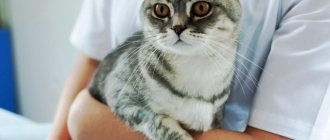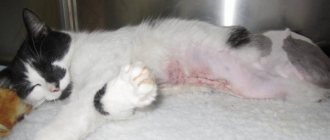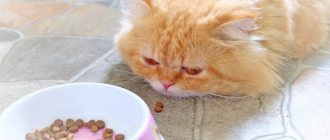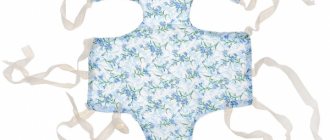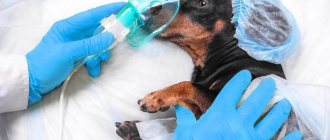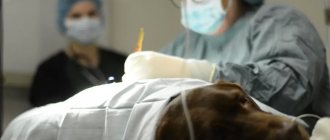Sterilization of cats is a surgical procedure that involves the removal of reproductive organs, which leads to loss of reproductive function and the cessation of external manifestations of sexual desire. Such a radical procedure is often resorted to by owners of domestic cats who do not want to bother with their offspring.
Sterilization is carried out by experienced doctors in a veterinary clinic. After such a procedure, the animal must be properly cared for, which will eliminate possible postoperative complications.
In the article we will talk about the features of caring for a cat after sterilization, how to treat sutures, when to remove the blanket, how to feed it properly, when you can drink water, after how many days the animal can be washed, why a cat should not jump, and what else is unacceptable to do after surgery.
Briefly about sterilization methods
In many ways, how quickly the cat’s recovery will proceed depends on the method of sterilization (properly castration).
There are 3 common methods of sterilization in cats:
- An incision along the linea alba. Most often practiced by veterinarians. The recovery period takes longer. But the method is considered less dangerous in terms of consequences for the cat.
- Lateral access. Sterilization through a side incision requires less postoperative care since there is no large suture. However, the risks of complications are high. Rarely used.
- Laparoscopy is an operation through a lateral but small incision (puncture). It is carried out using a special device - a laparoscope. Sutures are also applied, but they are small and dissolve on their own. Cat care is minimal. This operation requires highly qualified specialists and is not performed in all clinics, including due to lack of equipment.
Depending on the method of castration, the age of the pet, the presence or absence of diseases, the doctor gives recommendations on how to care for the animal. This also determines how many days the rehabilitation will last.
Prohibited Products
Some foods must be permanently removed from a neutered cat's diet to avoid health problems. Calcium, phosphorus and magnesium salts pose a great danger. They can be deposited in the organs of the excretory system, which contributes to the development of urolithiasis. Fish and seafood contain large amounts of phosphorus, so such foods should not be given. Occasionally you can pamper her with a small piece of low-fat sea fish, but only if she really loves this product. For example, you can support an animal in a state of stress in this way.
The list of prohibited products also includes:
- fatty varieties or parts of meat;
- oatmeal and semolina;
- fatty dairy products: cream, sour cream with a fat content of more than 6-10%.
There is no need to feed the animal potatoes. This vegetable has a high glycemic index. A cat does not need a high content of sugars and starch; this can quickly lead to excess weight gain. Legumes are difficult to digest, so you should not feed them to a sterilized cat either.
It is prohibited to give human products: smoked meats, sausages, fried foods, pickles and marinades. Such products contain a huge amount of fats, table salt, and spices that animals do not need. Sausages contain additives that are harmful to them and a lot of salt.
How to prepare a cat for castration
Preparing a cat for sterilization comes down to the fact that the pet is put on a diet - access to food is limited for 12 hours. And on the day of the operation they don’t even give you water.
It is advisable that the cat be vaccinated before castration. This will reduce the risk of viral diseases against the background of weakened immunity.
Veterinarians also recommend treating the cat for worms and external parasites 1.5-2 weeks before surgery.
You will need to buy 2 blankets. One will be immediately put on the animal in the veterinary clinic. The second one will be needed to replace it.
For some cats, the risk of anesthesia is especially high. This category includes:
- Older cats that are sterilized after 7 years.
- Maine Coons, British Shorthairs and all varieties of Scottish cats due to possible hereditary heart disease.
- The Persian breed is at risk for kidney disease.
Therefore, such animals require preliminary examinations.
After the operation, the doctor will tell you how to care for your cat after sterilization at home. And the owner’s main task is to follow the veterinarian’s advice.
General recommendations
After surgery, the cat’s abdomen is protected with a special blanket or bandage that is tied on the back. Such a protective blanket is constantly on the animal until the stitches are removed, plus or minus a day or two. This is done to prevent the cat from licking wounds from threads.
The blanket is made from natural cotton fabric, which does not physically interfere with the animal after surgery. However, there are times when, due to its sensitivity, the cat is too lazy to walk in this bandage or she walks in an unusual way. As soon as the blanket is removed, everything will return to its place. Be sure to ensure that the cat does not get caught in the blanket to avoid injuring itself.
How does a cat recover from anesthesia?
Sterilization surgery by any method is performed under anesthesia. It is advisable that the cat spend the first hours in a hospital under the supervision of a doctor. In some clinics, you can leave the patient for 12 hours so that he comes home fully awake from anesthesia. Then the animal will calmly navigate in space and move independently. But if it is not possible to leave it in a hospital, then you will need to take care of the animal at home.
When a cat comes to its senses after anesthesia, it looks lethargic and weak. She cannot overcome obstacles, bumps into objects, is poorly oriented in space, and walks staggering.
The cat's behavior will seem somewhat frightening and strange to the owner - the animal will try to run and stop abruptly, fall on its side, run into objects without seeing them in its path. This behavior is normal.
When vomiting, which also happens from anesthesia, it is necessary to help the cat and clean the oral cavity so that it does not choke on the vomit.
When to feed a cat after sterilization
After anesthesia, the functioning of the digestive system is not restored immediately. The animal has difficulty swallowing and may cough. Therefore, you can feed your cat after sterilization only after 24 hours. But if the rehabilitation process went quickly, for example, the laparoscopy method was used, then after the operation the cat can begin to eat within 8 hours.
It is normal that your appetite will be poor. Therefore, it is better to give wet food in the first 2-3 days after sterilization. It is advisable to give only a third of the daily dose on the first day, dividing it into 3 feedings.
As for drinking, water is offered to the animal 4-5 hours after the operation. But if the cat is not able to drink on its own, which happens due to swallowing reflexes that have not yet recovered, then you can use a syringe or pipette to pour a little water into the mouth. The next day after sterilization, the cat usually drinks on its own.
Veterinarians advise further feeding with special ready-made food for sterilized animals. This diet helps prevent many diseases and obesity.
Behavior of a neutered cat
Initially, the operated animals were in a state close to lethargy. This behavior of a cat after castration is completely normal. It lasts several hours, after which the pet gradually recovers from anesthesia. Lack of appetite and thirst for 12 hours after castration is also normal.
Physical activity is contraindicated for one week after surgery.
You should try to prevent him from running, jumping and playing. At the same time, the cat should be comfortable. Experts recommend placing him in a small closed container where he can stand up to his full height and take different poses, but nothing more.
The bottom of the temporary house should be covered with something soft. It is better to place the cat on the right side to reduce the load on the heart. It is necessary to constantly monitor the animal - even during sleep. If you suddenly start vomiting, you may choke. Visiting the street and communicating with other animals or children immediately after sterilization are excluded. It is important to provide maximum love, care and peace.
At first, the cat may seem lethargic and passive. Aggression often occurs a few days after surgery. Neutered cats scream, usually rush or, conversely, move away from people. This is due to physical discomfort, as well as changes in hormone levels. Your pet's behavior should be treated with understanding and patience. When the rehabilitation period is over, the cat will become even more gentle than before.
Postoperative blanket
The owner's task is to prevent the cat from licking the seam. And she will definitely do this after sterilization, because she is clean by nature, and will try to remove these “extra formations” on the skin.
The cat can chew the seam with its teeth or damage it with its rough, sandpaper-like tongue. From such actions, the seams may come apart and the skin may become inflamed. Therefore, a postoperative bandage (blanket) is required for a cat. In addition, the blanket will protect against dirt and moisture. The bandage is already put on at the clinic.
The cat usually resists wearing a blanket for the first day, and already on the second day it begins to react more calmly, getting used to the new clothes. But if the owner notices that the pet is uncomfortable moving in the bandage, it shakes its legs, limps, or crawls on half-bent legs, bends down to the floor, then the straps are probably tightened too tightly. You need to remove the blanket for a while and observe the animal. If the cat stops limping, simply tie the bandage less tightly.
The animal wears a bandage until the stitches are removed - 1.5-2 weeks. And preferably another couple of days after the stitches are removed to make sure that the scar has healed. The blanket is removed only while the seams are being processed.
Bandages are sold in pet stores and pharmacies. Sizes can be selected for any cat up to 10 kg. The bandage has 7 pairs of ties. Instructions on how to tie a blanket are on each package.
You can also make a “shirt” yourself. The main thing is to use soft, breathable fabric. All you need to know is body length, paw and chest volume. Cut holes for the paws on a piece of fabric, sew on the ties - you're done.
If a blanket is not used, then the second option for preventing seam licking is a protective collar. This is a cone-shaped product that is placed around the animal’s neck and prevents the tongue from reaching the stomach.
Observation of the surgical incision and treatment of sutures
Caring for your cat after sterilization includes monitoring the stitches. In turn, suture care depends on the sterilization method and what material the doctor used (absorbable threads or those requiring removal). After the operation, the veterinarian will tell you whether the stitches need treatment.
To process seams, use:
- Antiseptics – Chlorhexidine, Hydrogen Peroxide, Dioxidine. The seam is watered or the solution is dripped from a pipette.
- Levomekol ointment - used once a day to treat the wound.
- Special sprays (Aluminum spray, Veteritsin spray, Chemi spray). After applying the aerosol, a dense film is formed on the surface of the skin, which prevents infection and accelerates the healing process of wounds. Such sprays are more often used in veterinary clinics.
The sutures are removed after 7-10 days or they dissolve on their own.
If self-absorbable suture material was used, then the cat owner does not need to come to the clinic to have the sutures removed. The owner will see on his pet’s belly only a fold of closed skin edges from 1.5 to 5 cm long.
During laparoscopy, 3 indentations are visible on the skin. These punctures also require stitches. Their care is minimal - just moisten them with Chlorhexidine. Over time, crusts form at the puncture sites and need to be soaked. Because in cats, unlike humans, the skin under the crust is not renewed. The seams are processed in this way daily until the blanket is removed.
Home care: general rules
Features of care largely depend on the type of sterilization. In some cases, the operated animal really needs careful and constant supervision, while in others it is enough to sometimes keep an eye on the pet, which can lead a normal life almost immediately after the operation.
Isolation and protection from stress
But for all these cases there is one common requirement: despite the condition of the animal immediately after the procedure, it must spend the first day (this is at least) in an isolated room, where other pets and small children do not have access. They will bother the operated pet, or even start playing with it (and this will end badly).
The pet should be protected from stress factors. While the animal recovers from the consequences of the operation, it is necessary to refrain from carrying out planned and unscheduled repairs, and during the first days it is generally necessary to talk more quietly and not check the cat’s condition every minute, as excessively intrusive care may make her nervous. Following just these two rules will prevent many troubles.
Proper nutrition
Proper feeding of the animal plays a huge role. Under no circumstances should you give your operated cat dry food, as well as “heavy”, fatty meat.
In the first case, the weakened body does not receive all the necessary nutrients, micro- and macroelements, and in the second, the digestive system spends too much energy on digesting such food, which is vital at this time.
During this period, veterinarians advise using either saturated broths or high-quality canned food designed specifically for feeding animals recovering from illness or surgery.
When can I bathe?
It is permissible to wash a cat after sterilization, regardless of the methods used, no earlier than the stitches are removed. Bathing is stressful for the animal and risks causing pain and infection. If the seam becomes dirty for some reason, it is washed with a gauze swab soaked in antiseptic.
The need to wash a cat arises if the fur becomes wet due to involuntary urination. But even here, experts recommend using dry shampoo. In this case, you must not allow the product to get on the wound.
Postoperative complications
Sterilization is a safe operation. On average, the cat recovers completely within 10 days.
There is a reason to contact a veterinary clinic if:
- The cat has a fever that has lasted more than 3 days. Or vice versa, body temperature is lowered. Therefore, you need to be able to measure your pet’s body temperature, as well as have information about the norm and deviation.
- The animal experiences pain when its belly is touched.
- Under the skin in the wound area, upon palpation, a large accumulation of fluid is felt.
- The swelling does not subside from the wound for more than 5 days.
- The cat eats poorly and is constantly drowsy.
- The appearance of blood from the anus or vulva indicates the development of internal bleeding.
- Increasing the volume of the cat's belly.
- Diarrhea does not stop within 3 days.
- Frequent vomiting.
- Defecation and urination did not return to normal within 72 hours after surgery.
- Lethargy, depression, depression.
Complications occur more often in animals that have not been vaccinated. Because being in a public place (clinic) increases the risk of contracting viral infections. Many viral diseases are manifested by vomiting, diarrhea, and lacrimation. It is clear that a healthy cat should not show such symptoms after surgery. Therefore, before sterilizing an animal, it is recommended to undergo a vaccination procedure.
How long does it take to sleep under anesthesia?
The duration of deep sleep in an animal can reach 7 hours.
The operation itself lasts about 25 minutes, but the cat sleeps under anesthesia during the first day and takes a long time to recover. During this time, the animal does not react to sounds, smells, does not eat or drink, and periodically wakes up. Very deep sleep, when the animal is as if unconscious, lasts about 7 hours, then the cat begins to move, but falls asleep again. If your pet cannot wake up beyond this period, you should urgently consult a veterinarian.
